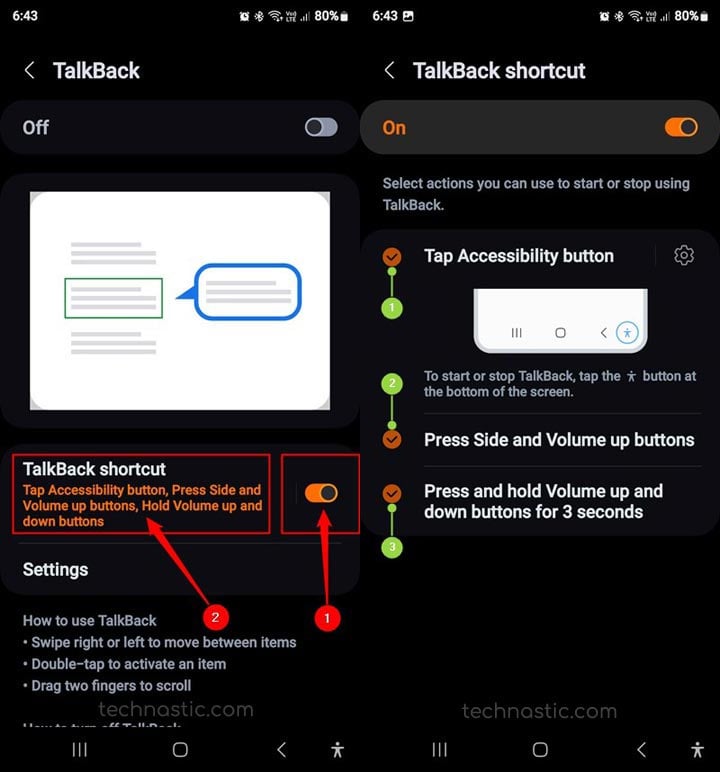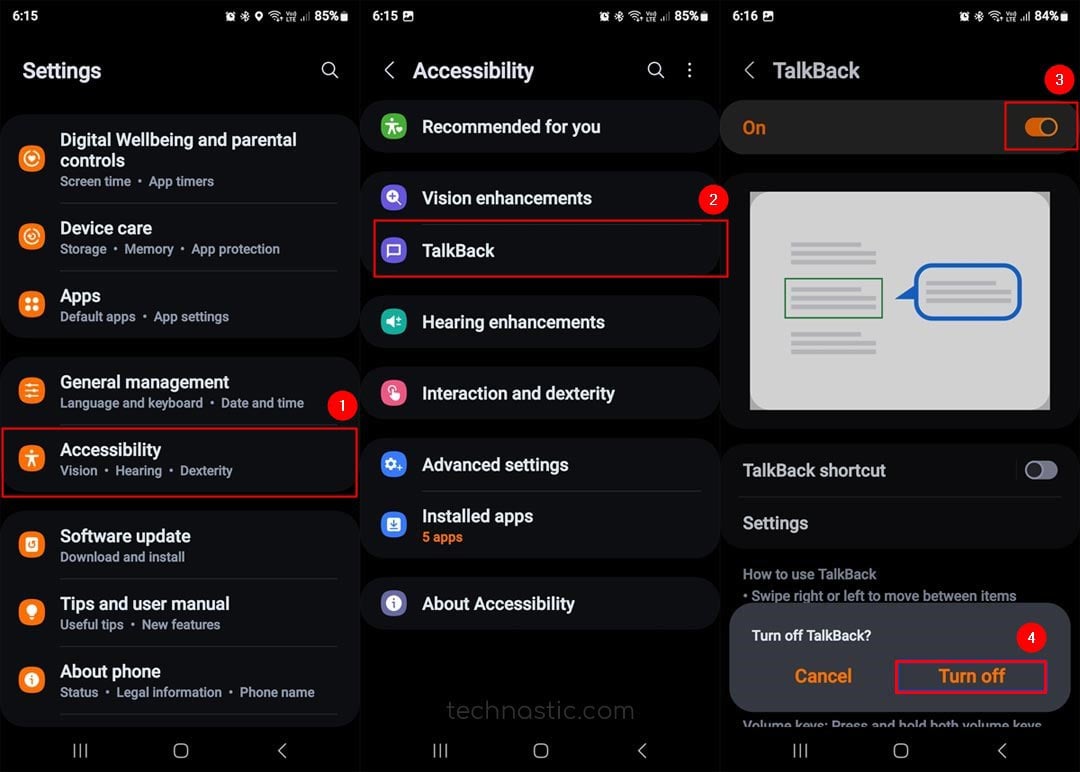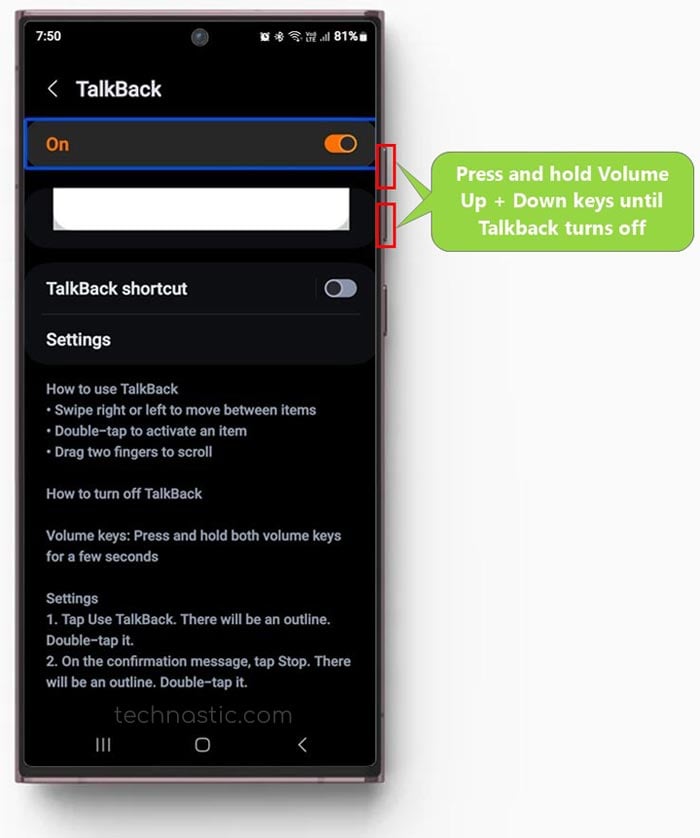When enabled, Talkback provides spoken feedback and notifications to help blind people by describing what they touch, select, and activate on their Android devices. While it is helpful for partially-sighted or blind people, normal people might find it pretty irritating. This tutorial will explore various ways to turn off TalkBack on Android. The 6 methods described below include disabling TalkBack from device Settings using touch gestures, hardware keys, a voice command, and ADB.
TalkBack is a part of Android’s comprehensive Accessibility settings. The TalkBack mode has accessibility permissions that authorize it to perform various tasks. It takes full control of your phone to read the content on your phone’s screen including PINs and passwords and track your interactions with an app and hardware sensor. It is also known as Screen Reader, Voice Assistant, SoundBack, and KickBack.
Let’s check out all possible methods to disable TalkBack on Android devices.
1. Using Voice Command in Google Assistant
If you use Google Assistant voice commands on your device, you can easily deactivate TalkBack with a voice command.
- Hold the Home button on the navigation bar to activate Google Assistant.
- Just say ‘Hey Google, turn off TalkBack‘.

- You’ll listen to the TalkBack assistant saying, “TalkBack is turned off”.
2. Using TalkBack Shortcuts
The following 3 methods to turn off TalkBack will work depending on the shortcuts you have enabled. Android supports different TalkBack shortcuts for quick access without navigating to Accessibility settings. Navigate to Settings > Accessibility > TalkBack and tap the switch next to the TalkBack shortcut. Then select the TalkBack shortcut option to enable it.
Having enabled the shortcuts, you can turn Talkback off or on whenever you want without going to device Settings.
1. Turn off TalkBack Using Volume Keys
You can also turn off TalkBack on Android devices without navigating through device settings using hardware keys. Press and hold the Volume up + Down buttons simultaneously for 3 seconds. Keep the volume keys pressed until you hear a confirmation that TalkBack is turned off.
2. Toggle TalkBack by Tapping the Accessibility Button
If you have enabled this TalkBack shortcut, you can easily enable or disable it by tapping on the Accessibility button located on the navigation bar or the floating button. You can single-tap and then double-tap on this TalkBack shortcut to turn it off or on.
3. Using the Volume Up and Power Keys
This TalkBack shortcut involves pressing the Volume up + Power buttons together. Doing so will turn off TalkBack if it is enabled and vice versa.
3. Turn off TalkBack or Using Gestures
Navigating your device settings when the TalkBack mode is enabled may be tricky. You must use touch and finger gestures to navigate, scroll input text, and select the on-screen options or items when TalkBack is enabled.
- Single tap: Tap with one finger to select an app, option, or on-screen item. The selected item is highlighted with a blue outline.
- Double-tap: Tap 2 times in a row to open an app, or select an on-screen item.
- Swipe up and down: You can swipe up and down with 2 fingers to scroll up or down.
Once familiar with the finger gestures, you can easily get past the lock screen and find your way to Settings > Accessibility > TalkBack to disable it.
- When the screen is locked, use your fingerprint or face to access the home screen.
- To unlock your phone using a PIN or password, turn on the lock screen, swipe up with 2 fingers, and tap the number. Samsung users can type the password with a single tap. On Xiaomi devices, however, you’ve to tap the number button to select and then double-tap to input it.
- Now open the Settings app.
- To do so, open Quick Settings by swiping down with 2 fingers from the status bar and then double-tap the Settings (⚙️)icon. Alternatively, you can open the app drawer by swiping with 2 fingers from the bottom of your home screen.
- Swipe up with 2 fingers to find Accessibility in Settings. On some Android devices, you may find the Accessibility menu under System/Additional settings/More settings.
- Tap Accessibility once followed by double-tap to open it.
- Now, open TalkBack using the same tap patterns.
- Finally, tap the toggle button next to TalkBack once and then twice on the Turn off option on your Samsung, OnePlus, Xiaomi, or any other Android phone.

4. Turn Off TalkBack via ADB
You can perform several tasks and tweak system settings on Android with ADB. You can use an ADB Shell command to easily enable TalkBack without going to settings.
Download and set up the SDK Platform-tools on your computer, type the following command, and hit Enter. To save time and avoid typos, copy the command using Ctrl+C and paste it into the command window.
adb shell settings put secure enabled_accessibility_services com.android.talkback/com.google.android.marvin.talkback.TalkBackService

Alternatively, you can use the following command to force stop TalkBack:
adb shell am force-stop com.google.android.marvin.talkback
So, this is how we can turn off TalkBack on the lock screen of any Android phone or tablet. Should you get stuck at any step mentioned in this tutorial or are confused, do not hesitate to ask.
Read Next: Complete List of Android USSD and Secret Codes

